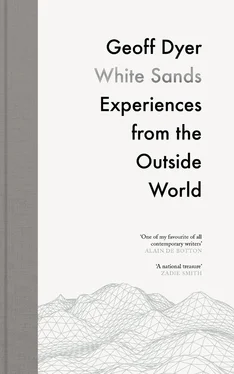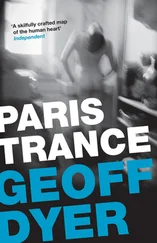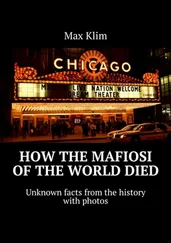Those earlier mentions of Mingus and Cherry were not just circumstantial: in another passage in Underworld the towers put DeLillo’s narrator in mind of ‘a kind of swirling free-souled noise, a jazz cathedral.’ The improvised nature of the undertaking, of learning in the process of doing and making — of being in the grips of something without necessarily being sure what the outcome will be — seems intrinsic to it. But jazz, in essence, is communal, and by Mingus’s time there was a considerable history and a large body of theory to draw on — or reject. Rodia worked alone, building his intricate and epic solo inch by inch, without the benefit of architectural theory or the support of collaborators like Dannie Richmond, Roland Kirk or (in Ornette’s case) Cherry and Haden. What he most wanted from the community — which may have been the motive for buying his plot of land here in Watts — was to be left alone, to go about the business of bringing this thing into an existence that would owe nothing to anyone else, but which would end up being for everyone.
Actually, the other half of that phrase from Underworld —‘cathedral’—is as important as the adjective ‘jazz.’ From certain angles, especially in photographs, the towers loom over the landscape like the shirey spires of English cathedrals in Gloucester or Salisbury. But the crucial thing is that at some point the comparisons fall short, as it were, of the ramshackle magnificence of Rodia’s structures. The comparisons are helpful because they emphasise the towers’ defining what-else-ness . But let’s stick with the cathedrals for a moment and see how they measure up.
Raymond Williams once spoke of how, though moved by the great English cathedrals, he saw ‘the enormous weight of them on man.’ He was amazed by the ‘sheer material effort involved in the production of these buildings, many of them fine churches in stone which have survived from periods in which hardly anybody actually would have had a stone house.’ On the one hand, it is ‘perfectly clear that this was a mode of construction imposed from above.’ On the other, they suggest a willingness to expend huge amounts, ‘often under protest but at times of their own will, of productive labour on buildings which had nothing whatever to do with satisfying the physical urgency of survival.’ The people doing this were physically exposed ‘at the very time when they were building shelter for an authority which was not human, which was not of them.’
Rodia worked by day for the means of survival and continued to labour in the evenings and at weekends, working on something that had nothing to do with either necessity, survival or personal gain. He was under no external compulsion to do this and was not collecting any tithe from the community to fund his efforts; nor was he being paid. Naturally, before he worked on his towers he had to make sure he had a house, a shelter for himself. The towers that he went on to create were not designed to shelter any kind of authority. They are an expression of authority — of his authorship — and therefore of his humanity. If that — humanity! — sounds sentimental or lazy, we can go back to another passage from Williams, in his book The Country and the City .
About the spread, in the eighteenth century, of English country houses and the ideas of ‘heritage’ they incarnate, Williams is less ambiguous. Yes, such houses are invariably beautiful, but
Think it through as labour and see how long and systematic the exploitation and seizure must have been, to rear that many houses, on that scale. See by contrast what any ancient isolated farm, in uncounted generations of labour, has managed to become, by the efforts of any single real family, however prolonged. And then turn and look at what these other ‘families,’ these systematic owners, have accumulated and arrogantly declared. It isn’t only that you know, looking at the land and then at the house, how much robbery and fraud there must have been, for so long, to produce that degree of disparity, that barbarous disproportion of scale. The working farms and cottages are so small beside them: what men really raise, by their own efforts or by such portion as is left to them, in the ordinary scale of human achievement. What these ‘great’ houses do is to break the scale, by an act of will corresponding to their real and systematic exploitation of others.
Seen in this light the houses become ‘a visible stamping of power, of displayed wealth and command: a social disproportion which was meant to impress and overawe.’
To read this passage is to be moved still more deeply by Rodia’s towers. First, again in contrast with the building of the cathedrals, because no tax was levied on the surrounding community. Second, because Rodia was able to produce, in his own words, ‘something big’ only by dint of an effort that goes so far beyond the scope of ‘ordinary human achievement.’ In its way it exists in the same relation to the ‘ordinary’ as a Beethoven sonata does to someone teaching himself basic tunes on a piano. While Williams has to urge us to view a country house and ‘think it through as labour,’ it is impossible to look at Rodia’s towers as anything other than labour, without thinking of the extraordinary work involved in their construction. How else could we regard them? So, yes, in certain extraordinary circumstances, what one family — one man — can produce is not ‘so small’ if his hobby consumes his entire life to the extent that there is no room in it for a family. The towers are disproportionately large compared with the surrounding bungalows and railroad tracks, which so often serve as indicators or gauges of flatness, but they do not ‘break the scale.’ They are not a visible stamping of power, still less, in another of Williams’s phrases, ‘visible triumphs over the ruin and labour of others’; instead, they’re a gift. They don’t make the buildings around them shrink but have served to raise up the surrounding community — almost as if, to revert to the idea from Heidegger mentioned earlier, the towers caused Watts to be founded around them.
Which makes it still more of a shame that a condition of the towers being protected and conserved is that they are surrounded by that unclimbable steel fence. The great country houses were designed to be seen and to keep people out. Within Rodia’s modest plot and its low walls, the structures were designed to be part of the community. Hence the name he inscribed in them: ‘Nuestra Pueblo,’ our city. The necessary fence grants the towers a special status, which their specialness explicitly rejects. The harm done by this fence does not stop there. At the same time that the fence annexes off the towers it also shrinks them, reduces their scale. They feel confined, ghetto-ised. It’s a far cry from the early sixties, when, as Thom Andersen puts it in Los Angeles Plays Itself , ‘the Watts Towers were the first world’s most accessible, most user-friendly civic monument.’ He illustrates his point with nutty footage shot there by Andy Warhol in 1963. It’s impossible to cavort around like that now, or even to be photographed in the way that Cherry was. You cannot be photographed by the Watts Towers; you can only be photographed by the fence that surrounds the towers. Stonehenge has been similarly shrunk — very nearly destroyed — by the measures designed to protect it.
The fence is doubly frustrating since the essence of the towers is that they are self -contained. At a certain point, when he was quite high up, Rodia was able to work from within the safety of each of the towers, so that the thing he was building — that grew around him — also served as a safety feature. Beyond that point, as the radius of the spire tightened, he had to step outside the spiralling cage but no scaffolding was used. The towers were —and remain — scaffolding: a highly decorative exo-skeleton for an absent interior. They were built with simple tools, with Rodia’s own hands, from basic materials — rebar, steels twisted and bent together without welding, bolts or rivets — so that the intimacy and intricacies of their construction are not concealed but laid bare. The sense is of something organic rather than planned: as if blood flowing through one of the main structural arteries will end up going though the smaller decorative radials. The hieroglyphics and patterns imprinted in the wet cement were formed by the tools used in the towers’ construction: hammers, the head of a garden hose. All of which adds to the impression of self-containment. If the towers are temples, they are dedicated to their own construction. Our guide told us that the legal limit on the height was a hundred feet. That, she said, was why Rodia brought the tallest of the three spires in at ninety-nine and a half feet. She might be right, but Rodia’s story is adorned with sentiment — bits and pieces of good feeling that cling to the legend like the broken bits of crockery and glass that he stuck into the cement of his towers. It is possible that the achieved height created the ceiling beyond which they were officially forbidden to grow. Freed from bureaucratic interference, they could implicitly have continued on forever, ad astra , in spite of the foundations being less than two feet in depth.
Читать дальше












